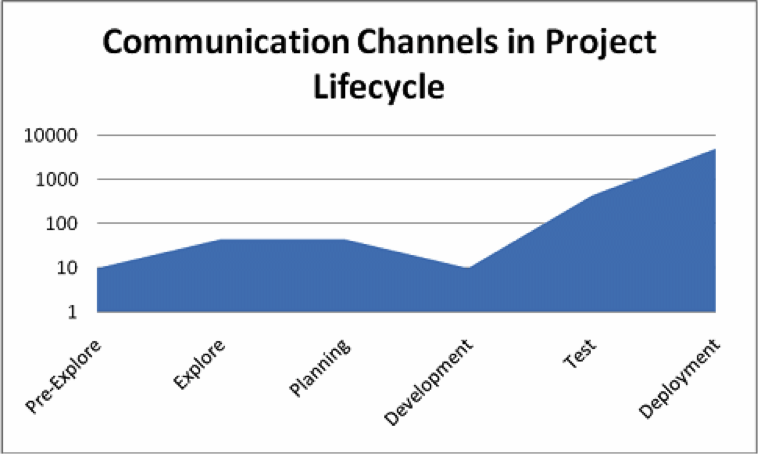Should you blog your project?
We have all been told that communication with all stakeholders, particularly the core project team, is one of the central responsibilities of the project manager.
You may have seen a well-known communications formula of ‘N(N-1)/2’ used as proof that the addition of new members to any program or project team increases the number of communication channels exponentially. For example, if your team increases from 15 to 17, the number of possible communication channels goes up by 31; try the calculations and you’ll see what we mean.
Applying this theory, a small team may have 10-50 communication channels, while a large team may have thousands. A project manager should understand that the time required to manage communications grows with the number of channels, and begin to look for ways to effectively and efficiently communicate with their project stakeholders, keeping in mind that different stakeholders require different information at different times in the project. Blogging may be a good communication option for your project.
Project lifecycle communications
Because each project phase requires the appropriate emphasis at a given time, the number of channels the program or project manager must manage varies throughout the lifecycle of a project. For example, in the early stage of a project, let’s call it preliminary, you may have a relatively low number of channels because you are only working with a few key stakeholders.
In contrast, in the execution or deployment phase, your team will be fully engaged with many people. Further, communication by the project manager is a key area of focus as the project lifecycle draws to a close.

Clearly, managing communications with a large number of users can be challenging. As program/project managers, we are typically overly reliant on email to both send and receive written messages to stakeholders. This may entail managing a distribution list, and you can never be sure if you are over-communicating or under-communicating.
In terms of communication, a good rule of thumb is that it’s better to over-communicate than to do too little. We strive to be ‘masters of our craft’ and, therefore, we want to find a method by which we ensure that necessary and sufficient information is communicated, and that we are not saturating our team, customers, and other stakeholders with ‘ToMITO’ (Too Much Information Too Often).’
One suggestion to aid project communications to certain stakeholders is to use a blog or an online forum, perhaps by utilising the features of your company’s intranet site or a secure site that offers this functionality.
Blog your project
Blogs are a great way to send a general message or update to your audience. Wikipedia defines a blog as:
A blog (a truncation of the expression weblog)[1] is a discussion or informational site published on the World Wide Web and consisting of discrete entries (“posts”) typically displayed in reverse chronological order (the most recent post appears first).
Many blogs provide commentary on a particular subject; others function as more personal online diaries; others function more as online brand advertising of a particular individual or company. A typical blog combines text, images, and links to other blogs, Web pages, and other media related to its topic. The ability of readers to leave comments in an interactive format is an important contribution to the popularity of many blogs. Most blogs are primarily textual, although some focus on art (art blogs), photographs (photoblogs), videos (video blogs or “vlogs”), music (MP3 blogs), and audio (podcasts). Microblogging is another type of blogging, featuring very short posts. In education, blogs can be used as instructional resources. These blogs are referred to as edublogs.
Stakeholders can choose or decline to subscribe to your blog updates. Forums are also an effective means to provide feedback and generate discussion among your project team and users. The benefit to you is that you can easily share one-to-many or solicit many-to-many messages among your base and rid yourself of your distribution lists.
Use the following matrix to decide how to best use these mediums:
Are there downsides to blogging? For sure. Blogging will not be the communication mode of choice for all stakeholders, and it is certainly not the only channel to use. As with any well-planned project, you should conduct a full stakeholder analysis and build your specific communication plan based on the needs of your project team and their stakeholder ‘circle of influence’ (using models such as the RACI one to determine who is Responsible, Accountable, Consulted and Informed).
We also all know that stakeholders come and go on projects, so remaining current is vital. As stakeholder needs vary, a blog will not be the method for everyone, and you may have to duplicate information in different formats. For example, if you have an IT project in the testing phase, or a construction project and are carrying out the ‘punchlist’ or ‘snagging remediation works’, a bug/issue/defect report on a blog may not be appropriate—it may be too detailed. But a high-level summary may be appropriate for summary reporting to certain stakeholders. You will need to agree on the appropriate use of a blog and determine what should be tracked in formal documentation and other mediums of communication.
In conclusion, blogging can be a great string to the bow of the project manager for communicating information about your project to appropriate parties. Blogging should not be used to communicate all levels of information and its use should be planned, based on stakeholder communication needs as identified and agreed upon in your project communications plan.
Effective blogging is a skill. Much guidance material is freely available on the internet. If you are unfamiliar with blogging, we recommend you review a few of these readily available resources by searching for ‘tips for blogging’. Lastly, always follow standard legal, business confidentiality and corporate guidelines and ensure you respond daily to your blog comments.


